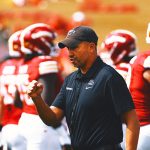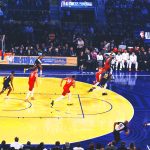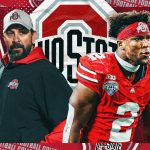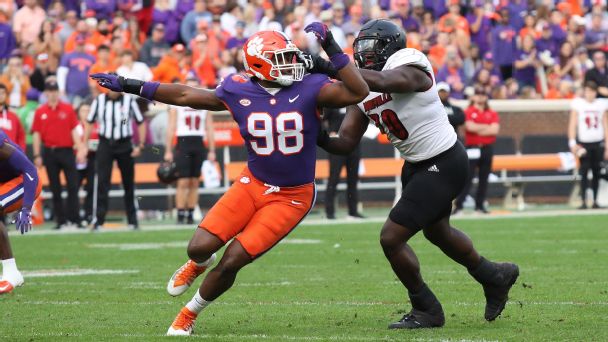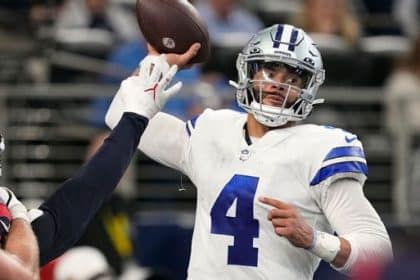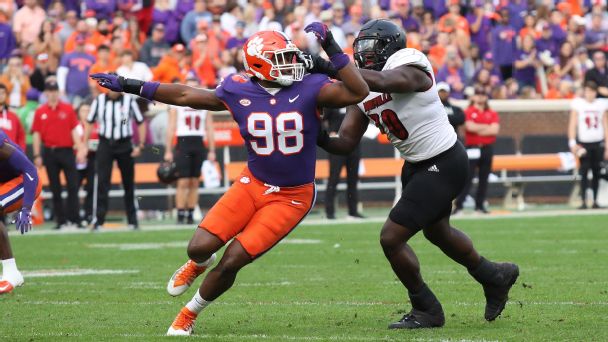
The 2022 NFL draft had a strong class of edge rushers, and three were drafted in the top five picks: Travon Walker (No. 1), Aidan Hutchinson (No. 2) and Kayvon Thibodeaux (No. 5).
Although not quite as loaded as the 2022 class, the 2023 draft class includes three edge rushers who are projected to go in the first 10 picks: Will Anderson Jr., Myles Murphy and Tyree Wilson.
SackSEER, Football Outsiders‘ statistical system for projecting the NFL success of college edge rushers, agreed that the 2022 class was strong. This year, however, SackSEER is much less bullish on the top available prospects.
Indeed, SackSEER would rank the top prospect in this year’s NFL draft behind all three of the top edge rusher prospects in last year’s class. That said, this could be a good draft for teams looking for value at edge rusher, as there are some intriguing players who might still be on the board in the second round.
Here is a ranking of the top edge rusher prospects for 2023, along with their projected sacks through five seasons and similar historical comps. Plus, we picked a potential sleeper prospect to watch:

![]()
SackSEER projection: 25.9 sacks through five NFL seasons
Scouts Inc.: No. 3 overall
Similar historical prospects: Ryan Kerrigan, Emmanuel Ogbah
Anderson is the consensus top edge rusher according to Scouts Inc., and SackSEER agrees. The question is whether he is worth the lofty price, as he will likely command a top-five pick.
He had very good sack production, recording 34.5 sacks in 41 games at Alabama. Anderson’s passes defended rate was below average, but only slightly so, and thus is not a major concern. He ran only one SackSEER drill at the combine — the 40-yard dash. He ran it in 4.60 seconds at 253 pounds, which is very good but is not good enough to surpass the greatest performances of edge rusher prospects in past drafts.
Anderson’s SackSEER projection is high enough that he should certainly succeed in the NFL — and maybe even become a star — but it also suggests that he might not be an elite prospect.
1:53
The plays that will have NFL QBs dreading Will Anderson Jr.
Check out LB Will Anderson Jr.’s highlights over his career at Alabama ahead of the NFL draft.
![]()
SackSEER projection: 24.5 sacks through five NFL seasons
Scouts Inc.: No. 11 overall
Similar historical prospects: Ezekiel Ansah, Rashan Gary
Van Ness never truly broke out as a pass-rusher at Iowa, but SackSEER suggests that his best days could be in front of him. He had a good combine, running the 40-yard dash in only 4.58 seconds and the 3-cone in only 7.02 seconds. These are extremely good times for a player who weighs in at 272 pounds.
Van Ness’s weakness is his production. His passes defended rate was average, and his best season for sack numbers was his freshman year, when he recorded seven sacks in 13 games.
Production is not everything, and there is a fairly long list of edge rushers who never hit double-digit sacks in a season in college but later did so several times in the NFL. You never want to bet too hard on an edge rusher without tremendous college production, but Van Ness offers tantalizing upside as a player with a great combination of size and skill.
![]()
SackSEER projection: 21.9 sacks through five NFL seasons
Scouts Inc.: No. 23 overall
Similar historical prospects: Derrick Morgan, Shaq Lawson
Murphy’s high projection is almost entirely thanks to his high projected draft position, as his SackSEER projection is a mix of mediocrity and question marks. His production is very similar to Van Ness’. He recorded 18.5 sacks and 5 passes defended in 35 games. However, he does not have the workout numbers Van Ness does. In fact, Murphy has no workout numbers at all. He did not do agility drills at the combine, and he sat out his pro day with a hamstring injury.
All of SackSEER’s drills are correlated with one another, so it is usually not a huge problem if a prospect misses one of the drills. However, when a prospect has no drills at all, the only thing SackSEER can do is project his drills based on his weight.
It could very well be that NFL decision-makers know (or suspect) that Murphy would post outstanding workout numbers if he could participate. In that case, it might be wise to disregard Murphy’s SackSEER number altogether. Absent that, SackSEER suggests that he might be significantly overrated at his projected draft position.
![]()
SackSEER projection: 20.8 sacks through five NFL seasons
Scouts Inc.: No. 58 overall
Similar historical prospects: Aaron Schobel, Chandler Jones
Foskey is the first prospect in SackSEER’s top projections who does not have a first-round projection, and he gets there through a combination of physical attributes and production.
His combine performance was a bit mixed but was strong overall. He ran the 40-yard dash in 4.58 seconds, which is amazing for a player who weighs in at 264 pounds. His vertical leap was just average at 34 inches, but his 10-foot-5 broad jump was much better. However, he had a relatively slow 3-cone at 7.28 seconds, which could suggest that he lacks the lateral agility of other prospects.
Foskey’s sack production in college was strong. He recorded 25 sacks in 37 games, with 20.5 of those sacks coming in his last two seasons. However, he recorded only two passes defended.
His good metrics are stronger than his bad metrics, so it balances out into a reasonably strong projection.
![]()
SackSEER projection: 20.6 sacks through five NFL seasons
Scouts Inc.: No. 27 overall
Similar historical prospects: Leonard Little, Julian Peterson
Aside from possibly one sleeper in the later rounds, SackSEER suggests that McDonald provides the best value of any edge rusher in this year’s draft. He is consistently strong in each of SackSEER’s metrics and has a profile that is very similar to those of prospects who have succeeded in the past.
McDonald performed the vertical leap and the broad jump at the combine, despite just recovering from a fever. He performed well, recording a vertical leap of 36 inches and a broad jump of 11-foot-0. He followed this up at his pro day by running the 40-yard dash in what has been reported as roughly 4.62 seconds. There has been some inconsistent reporting on what his 3-cone drill time was, but all of his reported times are exemplary.
McDonald’s production was also good. He recorded 10.5 and 11.5 sacks in his sophomore and junior years, respectively, before dropping to only 5.0 sacks as a senior. The drop in sack production is not too concerning — sometimes a dominant college player loses production after facing increasing double-teams and plays called away from him. He also recorded seven passes defended, which gives him a slightly above average passes defended rate.
His biggest weakness is his relatively small size at 239 pounds. However, several edge rushers weighing less than McDonald have found success, such as Leonard Little, Robert Mathis and Trent Cole.
This is a draft SackSEER thinks is weak at the edge rusher position and a bit overrated. In a draft like this, McDonald could provide terrific value in the second round.
![]()
SackSEER projection: 19.6 sacks through five NFL seasons
Scouts Inc.: No. 13 overall
Similar historical prospects: Barkevious Mingo, Trent Cole
Put simply, Smith blew up the combine. He ran the 40-yard dash in 4.39 seconds and is only the third player in SackSEER’s database to run a sub-4.40 40 — with the other two being Odafe Oweh and Amare Barno. His other explosion drills were also great — he recorded a 41.5-inch vertical leap and a 10-foot-8 broad jump. It is enough to make him one of the five most “explosive” edge rusher prospects of all time.
The bad news is that his college production was not great. Smith recorded only 12.5 sacks and 4 passes defended in 38 games with the Bulldogs. He is also undersized at only 239 pounds.
It’s easy to characterize him as a “workout warrior,” and there is certainly a long list of players who performed at the combine but could not produce at the college or NFL levels. However, success for Smith is far from impossible, as several edge rushers with relatively low college production and great workouts have become good pros, including Michael Johnson and the aforementioned Cole.
![]()
SackSEER projection: 19.2 sacks through five NFL seasons
Scouts Inc.: No. 50 overall
Similar historical prospects: Cliff Avril, Jason Pierre-Paul
Young is a similar prospect to Smith, but his profile involves a lot of small tradeoffs that would have put him ahead of Smith if not for Smith’s superior projected draft position.
Like Smith, Young also performed well at the combine, except that his numbers were not quite as eye-popping. He ran the 40-yard dash in 4.43 seconds, recorded a 38-inch vertical leap and slightly bested Smith at the broad jump at 12-foot-0. His combine was arguably more impressive because he recorded his numbers at 250 pounds, rather than 239. In that regard, he better fits the more typical size-speed profile for an edge rusher.
Like Smith, Young did not have outstanding sack production. Smith recorded only 12.5 sacks in 23 games with the Volunteers. However, unlike Smith, he had only two seasons of Division I FBS football, as his first two years were in junior college. Accordingly, Young’s production comes from a small sample size while he was relatively inexperienced, suggesting that he might have room to grow.
![]()
SackSEER projection: 18.9 sacks through five NFL seasons
Scouts Inc.: No. 5 overall
Similar historical prospects: Dion Jordan, Jamal Reynolds
Wilson, despite being rated as the fifth overall prospect by Scouts Inc., has a low SackSEER projection. It puts him behind several potential second-round talents, even after accounting for his high draft position. However, this projection comes with a huge asterisk because he has yet to perform any pre-draft agility drills because he has been injured.
To set the table, let’s start with why Wilson’s baseline projection is so low. He recorded only 17.0 sacks in 35 games with the Red Raiders, which gives him a much lower sack rate than prospects who typically go in the first half of the first round. In addition, he recorded only one pass defended in his college career.
It begs the question of whether his high draft position is based on an expectation that he has outstanding physical tools and that those would be reflected in agility drill numbers, which we do not have because of his injury. Without anything to go on, SackSEER projects his drills based only on his weight, which might not be representative of his true ability.
Let’s look at some of the best- and worst-case scenarios for his projections based on hypothetical workouts.
The best-case scenario is that Wilson has a Nolan Smith-level workout where his performance ranks among the historically great numbers on the drills SackSEER cares about. In that case, Wilson’s projection would skyrocket to 29.0 sacks, making him the consensus best edge rusher prospect in this year’s draft. More realistic is Wilson having a good but not historically great showing, much like Isaiah Foskey, which would bring Wilson to 23.2 sacks. This result would make his high draft projection more understandable, but it would still suggest that he was somewhat overrated as a top-10 pick. There is also the “disaster” scenario where he performs poorly, similarly to Tamba Hali (although he turned out to be a great pro), which would dip his projection to 15.3 sacks and would give him the worst SackSEER projection of any top-10 pick in SackSEER’s database, behind Clelin Ferrell and Dion Jordan.
Wilson has indicated that he plans to work out before the draft after skipping his pro day, so we might get more clarity in the coming weeks. At the moment, he is a huge question mark, but his low baseline projection suggests that it might be difficult for him to live up to his high status as a possible top-10 pick.
1:33
Tyree Wilson’s college mixtape shows why he’s an intriguing NFL prospect
Check out the best highlights that contributed to a stellar college career for Texas Tech’s Tyree Wilson.
Potential sleeper
SackSEER projection: 15.1 sacks through five NFL seasons
Scouts Inc.: No. 30 overall
Similar historical prospects: Margus Hunt, Will Smith
Adebawore might project as an inside end in a 3-4 or a defensive tackle on pass-rushing downs in the NFL, which would take him out of the scope of SackSEER altogether. However, since he was an edge rusher at Northwestern, we want to talk about how he would project as a traditional 4-3 end because he has an interesting profile.
Adebawore has an amazing size-speed combination, and it is puzzling why he is not getting more hype. He ran the 40-yard dash in 4.49 seconds at 282 pounds. Yes, you read that correctly — 282 pounds. As a point of comparison, Julius Peppers ran the 40-yard dash in 4.74 seconds at 283 pounds.
His size-speed projection is so out-of-bounds good that he kind of breaks SackSEER to the extent that it overlooks his pedestrian sack production. He had only 12.5 sacks in 36 games for the Wildcats. However, he had an interception and six pass breakups, which gives him a fairly strong passes defended rate.
It is highly uncertain how Adebawore’s unique profile will translate into pass-rushing success — or even whether his future team will use him to rush the edge at all. However, at the low price of a fifth-round pick, his unique combination of size and speed could result in him significantly overperforming his draft position.

